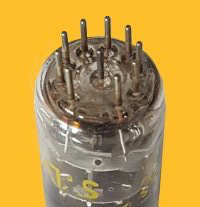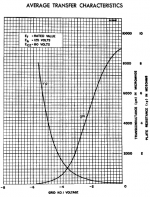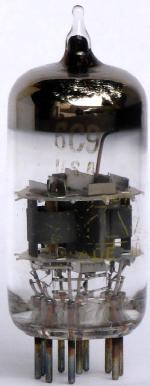
6C9_Twin-Tetrode
|
|
|||||||||||||||||||||||||||||||||
|
Hits: 3025 Replies: 1
6C9_Twin-Tetrode Curves
|
|
|
Joe Sousa
03.Apr.10 |
1
Fellow Radiophiles, The unusual 17C9/6C9 dual VHF tetrode seems to have no published curve traces. I wanted to know what they looked like. These two photos were taken from the TEK575 transistor curve tracer. Operation under nominal screen operation at 80V:
Operation with reduced screen voltage to see it's effect on the location of the tetrode kink. G2=40V: This VHF tetrode was used in FM tuner front ends after 1960. The implication is that the noise performance must have been comparable to that of a contemporary triode. The heater dissipation is 40% higher than that of 12AT7, yet the plate length is about half. The transconductance and capacitances are similar, except for much lower grid-plate capacitance of the 6C9 (0.06pF vs 1.6pF), as expected. The most common application was as an FM front end was with one tetrode as grounded cathode preamp, driving the other tetrode also with grounded cathode, but configured as self-oscillating additive converter. While the noise figure of the 6C9 might be comparable to the 12AT7, the expected overall gain as an FM front end should be higher. Regards, -Joe |
|
Rolf Nickel
05.Apr.10 |
2
Dear Joe,
thank you for presentation of the results from your measurements.
A radio which is equipped with the 6C9 tube can be found here:
Additional information about the 6C9 tube is shown at nj7p: It is worth mentioning that the 6C9 has 10 pins, No 10 (cathode 1) is located in the centre of the tube base. That means also a special tube holder with ten contacts. Circuit Description of the KG-50 FM section:
" ...The FM signals presented to the tuner are selected by components in the AM-FM Tuning Assembly. The tube in the Tuning Assembly (6C9) performs three functions: amplification of the desired signal, generation of the oscillator signal and mixing of the FM and oscillator signals to produce the IF frequency signal. The IF frequency in FM operation is 10.7 mc (MHz) rather than 455 kc (kHz) because the conversion of the very high frequency FM signals down to the low frequency of 455 kc would introduce unwanted signal responses and other problems such as drift, etc. Converting to an IF frequency of 10.7 mc eliminates these problems. ..." (Knight Kit Assembly Manual, page 34).
Best regards, Rolf
|
End of forum contributions about this tube
| Data Compliance | More Information |





